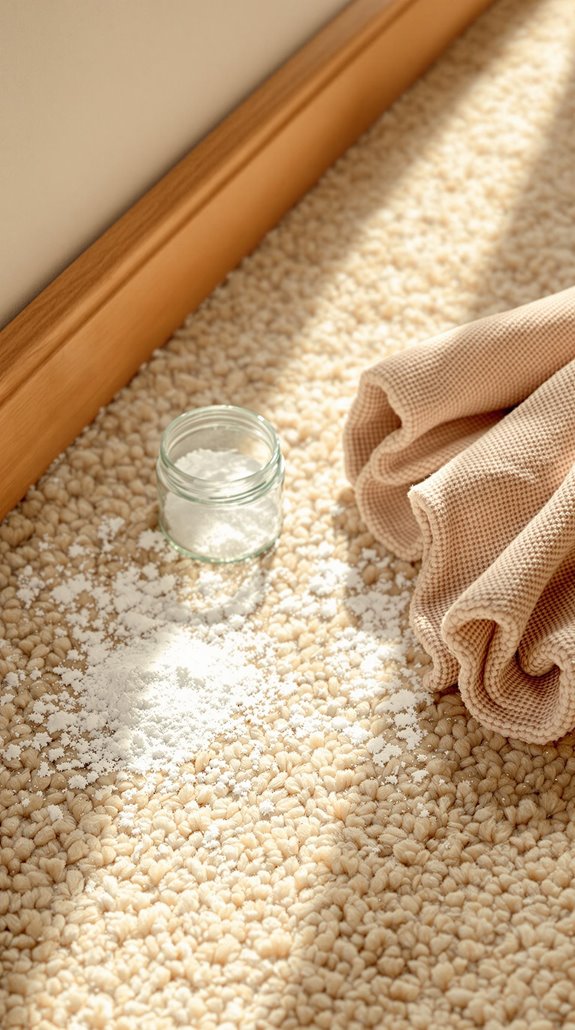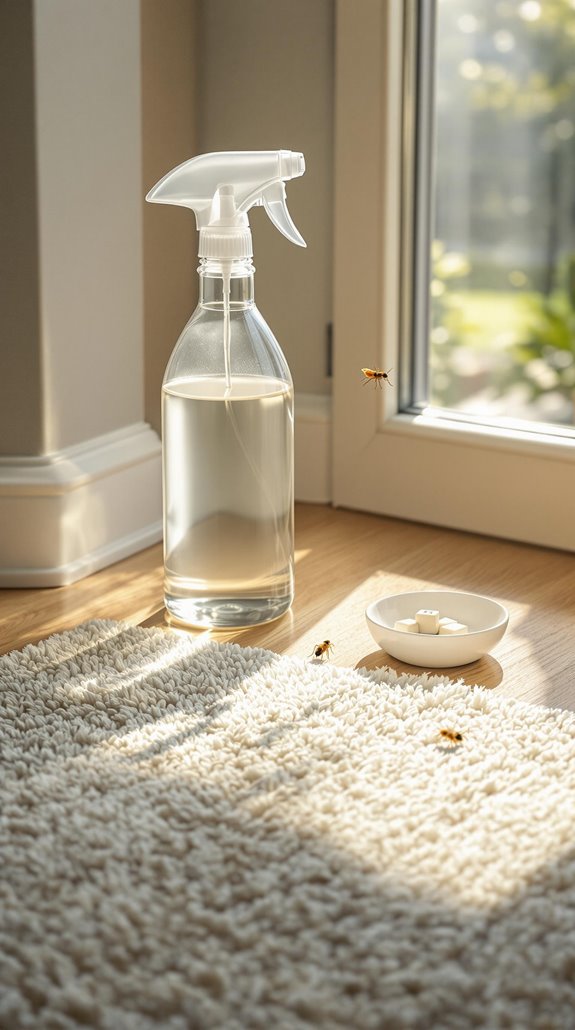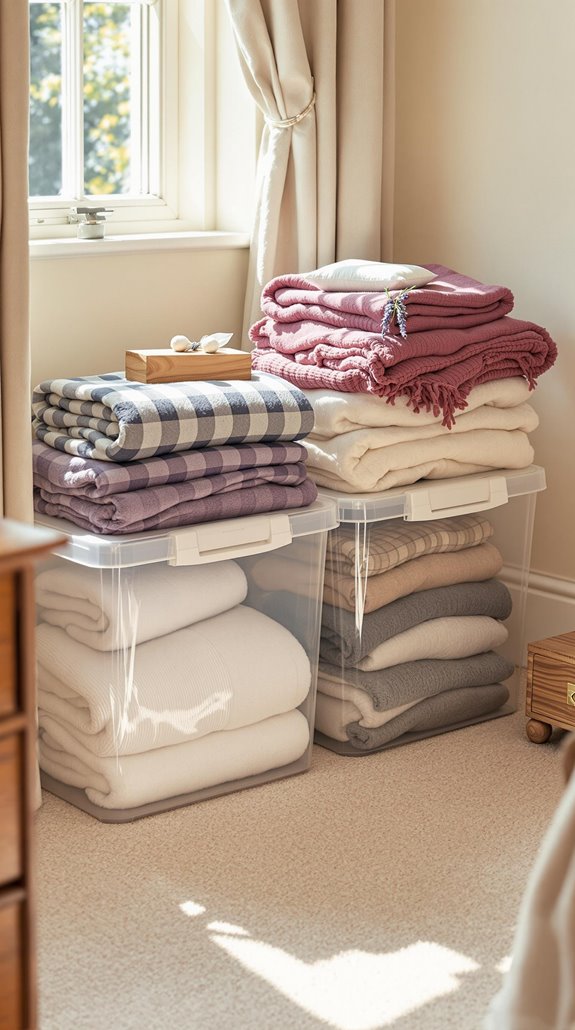I’ve dealt with carpet beetles in my UK home, and I’ll be honest—these tiny pests can cause serious damage to your fabrics, carpets, and stored clothing if you don’t act quickly. The good news is that you don’t need harsh chemicals to eliminate them effectively. Through trial and error, I’ve discovered several natural methods that work brilliantly in British homes, from targeted vacuuming techniques to specific essential oil combinations. Here’s exactly what you need to know to tackle this problem head-on.
Key Takeaways
- Use food-grade diatomaceous earth on carpets and baseboards, leaving for seven days before vacuuming to dehydrate beetles naturally.
- Create essential oil sprays with lavender and eucalyptus mixed with water to repel carpet beetles from upholstery and carpets.
- Maintain low humidity levels with dehumidifiers to prevent breeding conditions and hinder carpet beetle survival and reproduction.
- Seal entry points around windows, doors, and baseboards with silicone caulk and install fine mesh screens to block beetles.
- Store natural fiber items in airtight containers with cedar blocks or lavender sachets as natural repellents after thorough cleaning.
Thorough Vacuuming and Steam Cleaning Techniques

Eliminating carpet beetles requires a systematic approach that combines aggressive vacuuming with high-temperature steam treatment to destroy all life stages of these persistent pests.
I’ll clear furniture and inspect carpets with a flashlight, targeting larvae accumulation points. Using maximum suction with crevice tools, I vacuum slowly in overlapping strokes, spending 10-15 minutes per square metre. I focus on edges, seams, and baseboards where eggs hide.
After disposing vacuum contents in sealed outdoor bags, I steam clean within 24 hours at ≥130°F, holding the nozzle 15-20 seconds per section. I’ll repeat daily vacuuming for 7-10 days to catch newly hatched larvae.
Post-treatment, I ventilate rooms for 24 hours and maintain humidity below 50% using dehumidifiers to prevent reinfestation. A HEPA vacuum is particularly effective at trapping allergens and microscopic debris that standard vacuums might miss.
Hot Water Washing and Fabric Treatment Methods
Hot water washing stands as the most effective method for eliminating carpet beetles from fabric items, killing all life stages through sustained high-temperature exposure. I’ve found that temperatures above 60°C denature the proteins in larvae and eggs, ensuring complete eradication. You’ll need to maintain full immersion for at least 30 minutes, allowing heat to penetrate all fabric layers effectively.
For delicate items like wool or silk, I recommend professional dry cleaning instead. The solvents used kill carpet beetles without damaging precious fibers. After treatment, I immediately store cleaned items in sealed containers to prevent re-infestation. Focus your attention on inspecting dark, undisturbed areas where larvae typically hide, as these locations often harbor the most destructive stage of the beetle lifecycle.
Don’t treat just once—repeat every 7-10 days for four weeks to eliminate newly hatched larvae from any missed eggs, ensuring thorough control.
Diatomaceous Earth and Boric Acid Applications

Natural powders offer powerful solutions for carpet beetle control, with diatomaceous earth standing out as the most effective desiccant treatment available. I’ll guide you through the proper application method that works consistently.
You’ll need food-grade diatomaceous earth specifically designed for pest control. Scatter this fine powder directly in affected areas where you’ve spotted beetle activity. The powder works by dehydrating carpet beetles on contact, causing them to die within days.
Focus your application on carpets, baseboards, cracks, and crevices where beetles hide. Apply a thin, even layer using a duster or careful hand application. Leave the treatment undisturbed for at least seven days before vacuuming. The diatomaceous earth works by cutting through the beetle’s exoskeleton and absorbing essential oils from their bodies. Reapply as needed until the infestation clears completely.
Essential Oil Repellent Mixtures and Cedar Solutions
While diatomaceous earth provides physical elimination, essential oil repellents create protective barriers that prevent carpet beetles from establishing colonies in your home. I’ll show you how to create effective repellent mixtures using proven oils.
Lavender and eucalyptus oils deliver the highest repellency rates in controlled tests, outperforming clove and lemon oils considerably. I recommend mixing these oils with water in spray bottles for targeted application on carpets and upholstery. Tea tree oil disrupts beetle egg-laying behaviors through its antimicrobial properties, while peppermint oil overwhelms their sensory receptors.
However, avoid peppermint if you have pets—it’s toxic to cats and dogs. For maximum effectiveness, I combine neem oil with alcohol-water solutions, creating mixtures that halt breeding cycles while achieving cellular dehydration upon contact. Clove essential oil functions as an antifeedant, directly impacting beetle reproduction and growth patterns when applied consistently.
Vinegar-Based Sprays and Pheromone Trail Elimination

When carpet beetles establish colonies in your home, vinegar-based sprays deliver immediate lethal contact action through high acidity levels that disrupt their cellular functions. I’ll mix white or apple cider vinegar with water at a 1:1 ratio for equal effectiveness against adults, larvae, and eggs.
I target cracks, baseboards, and furniture edges with spray bottle application. For infested fabrics, I saturate the material for 30 minutes before vacuuming to guarantee penetration. Since vinegar provides no residual protection, I reapply weekly during active infestations.
To eliminate pheromone trails, I wipe floors with undiluted vinegar, removing organic residues that attract beetles. I’ll seal entry points with silicone caulk and deploy pheromone traps near light sources to interrupt their mating cycles effectively. Be aware that vinegar may attract flies, so monitor treated areas for any increased insect activity.
Temperature Control Through Freezing and Heat Treatment
Since carpet beetles cannot survive extreme temperatures, I’ll use freezing and heat treatments to eliminate entire colonies without chemical pesticides. I’ll maintain my freezer at -4°F (-20°C) to kill all life stages including eggs, or use -20°F (-29°C) for 72-hour treatment. For heat treatment, I’ll set my oven to minimum 120°F (49°C) for 30 minutes, ensuring the entire object reaches target temperature.
Before freezing, I’ll wrap items in plastic bags to prevent frost damage, then allow 24 hours to return to room temperature before handling. I won’t use these methods on fragile materials with inlays or mother-of-pearl that crack easily. For heat-sensitive items like certain plastics, I’ll choose anoxic treatment instead. These thermal methods are particularly effective since insecticide sprays often fail to penetrate deeply enough into infested materials to reach all life stages.
Humidity Management and Ventilation Strategies

After eliminating carpet beetles through temperature treatments, I’ll focus on preventing their return by controlling the environmental conditions they need to survive. Carpet beetles thrive in humid environments, making moisture control essential for long-term prevention.
I use dehumidifiers to maintain ideal humidity levels throughout my home. High humidity creates perfect breeding conditions for these pests while fostering mold and fungi that serve as primary food sources for carpet beetle larvae. Excessive moisture also accelerates the deterioration of natural fibers like wool, making them more attractive to beetles. Low humidity levels can actually hinder their survival and reproduction, making this an effective natural control method.
Sealing Entry Points and Installing Protective Barriers
While moisture control creates an inhospitable environment for carpet beetles, physical barriers provide the most reliable defense against future infestations. I’ll show you how to seal your home effectively.
Start by inspecting your entire property for entry points. Check windows, doors, baseboards, and utility penetrations where pipes or wires enter. Even tiny cracks invite beetles inside.
Seal stationary gaps with silicone caulk around window frames and door casings. Apply weatherstripping to movable components like doors and windows. Install fine mesh screens on all windows and vents – this blocks adult beetles while maintaining airflow.
Don’t forget door sweeps at exterior entrances. They eliminate the gap beneath doors where beetles commonly enter.
Make sealing part of your annual maintenance routine. Regular inspections catch new gaps before they become problems and help identify carpet beetle issues early.
Proper Storage Solutions for Susceptible Materials

Once you’ve sealed entry points, protecting your vulnerable materials through proper storage becomes your next critical defense. I’ll show you how to safeguard your woolens, furs, and natural fabrics from carpet beetle damage.
Use airtight containers like plastic garment bags, sealed trunks, or boxes – carpet beetles can’t chew through plastic. Fix any cracks or holes with tape before storing items. Clean everything thoroughly first to remove lint and hair that attract beetles. Insert paper layers between stored items to create additional barriers that help maintain the protective environment within your containers. Additionally, keeping your home free from wood worm infestations is essential to ensure that other pests do not find a way to thrive alongside carpet beetles.
Add cedar blocks or lavender sachets as natural repellents in your storage containers. For heavily infested items, try heat treatment at 120°F for 30 minutes or freeze them for two weeks below 18°F.
Keep deterrents away from children and pets, and avoid insecticides near plastic storage materials.
Removing Attractants and Maintaining Clean Environments
Since carpet beetles thrive in environments where food sources and debris accumulate, eliminating these attractants forms the foundation of effective long-term control. I’ll remove pet food bowls immediately after feeding and seal dry goods in airtight containers to deny beetles accessible nutrition. Dead insects on window sills and light fixtures need clearing fortnightly, as they’re prime food sources.
I maintain clean environments through strategic decluttering. Quarterly storage area cleanouts eliminate potential breeding sites, while biweekly microfiber cloth treatments on bookshelves and ornaments prevent dust accumulation. Monthly pantry shelf cleaning with vinegar solution removes food residues that attract beetles. Natural fiber items like woollens and silks require airtight storage to prevent carpet beetle access during off-seasons.
Don’t overlook external factors – I dispose of abandoned birds’ nests near the property and repair torn window screens immediately to prevent outdoor beetle migration indoors.
Conclusion
I’ve covered multiple natural approaches to eliminate carpet beetles from your UK home. You’ll need to combine several methods for maximum effectiveness – vacuum regularly, apply diatomaceous earth, use essential oil sprays, and control humidity levels. Don’t forget to seal entry points and store vulnerable fabrics properly. Consistency is key; you must maintain these practices to prevent reinfestation. With diligent application of these techniques, you’ll successfully eliminate carpet beetles naturally.
References
- https://www.fantasticpestcontrol.co.uk/carpet-beetles/how-to-get-rid-of-carpet-beetles/
- https://pestsoflondon.co.uk/say-goodbye-to-carpet-beetles-effective-strategies-to-eliminate-and-prevent-infestations/
- https://www.homebuilding.co.uk/advice/how-to-get-rid-of-carpet-beetles
- https://ipm.ucanr.edu/PMG/PESTNOTES/pn7436.html
- https://www.pestdefence.co.uk/news/how-to-get-rid-of-carpet-beetles/
- https://www.tomsguide.com/how-to/9-ways-to-get-rid-of-carpet-beetles-with-or-without-chemicals
- https://www.sunpestcontrol.co.uk/blog/how-to-get-rid-of-carpet-beetles/
- https://biopestcontrol.co.uk/2025/05/01/carpet-beetle-removal-tips-in-london-effective-methods-to-eliminate-these-pests-from-your-home/
- https://www.best4flooring.co.uk/blog/how-to-get-rid-of-carpet-beetles/
- https://pestcontrol.me.uk/local-pest-control-for-carpet-beetles/

